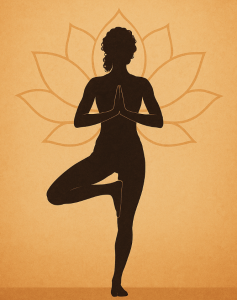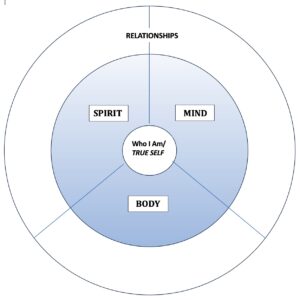Refinement is a necessary step on our evolutionary ladder toward self-actualization and fulfilment. Being aware of what forces drive our behaviour means we can adapt who we are, moment-to-moment. Each adaptation we make refines our skills, innate gifts and decision making in ways that uplift rather than belittle. In yoga vernacular, we call these driving forces gunas.
As I wrote in a previous blog, the gunas represent the three forces (sattva, rajas and tamas) that make up our universe and, thus, drive our fundamental human nature. Getting to know these forces (contentment, agitation and lethargy; respectively) is key to understanding our mind, that is, our mental-emotional experience. And, since we store unresolved emotion in our bodies, releasing such tension through understanding and appropriate action also enlightens our physical being and outer world.
… all that can be known in this world, tangible and intangible, is a manifestation of the gunas in their various forms. Rolf Solvik
From the verses of the Bhagavad Gita, Rolf Solvik offers a contemporary interpretation of how the gunas manifest in everyday contexts, such as:
- What you eat (17.8–10):
- Tastes good, promotes health, strength, and a pleasant mind (sattva)
- Oversalted, highly spiced and causes illness and depression (rajas)
- Stale, unwanted by others, and not fit as an offering (tamas)
- What you offer (17.20–22):
- Given at the right time, with nothing expected in return (sattva)
- Given reluctantly, or with the aim of gaining a returned favour (rajas)
- Given inappropriately or with disrespect or contempt (tamas)
- Your spiritual path (18.33–35):
- Helps you bring your mind, breath, and senses into harmony (sattva)
- Depends on your acquiring something you want (rajas)
- Preoccupies you with fears, grief, and excessive sleep (tamas)
- Your happiness (18.37–39):
- Arises from inner discrimination and increases over time (sattva)
- Overly sensual; sweet to begin, poisonous in the end (rajas)
- Arises from sleep, lethargy, and negligence (tamas)
Because the relationship among the three gunas typically occurs outside of our awareness, it can be challenging to keep them top of mind in daily life. A helpful action is to notice their internal emergence while you are in a yoga pose. For instance, when you are in Utthita Trikonasana (Triangle) are you relaxed, mindful and content (sattvic), or are you competitive, struggling painfully and agitated (rajasic), or are you lethargic, mindless and intoxicated (tamasic)?
Not to say that sattva is the goal, instead, observing the internal interplay of all three forces allows us to gently cultivate rajas and tamas in service of sattva. For example, rajasic change brings chaos and agitation, which precede creation (sattva). So then, how can we mindfully, gently cultivate this chaos and agitation into a pleasing creative expression? In such cases, your yoga practice or daily decision making might include —
- inserting a relevant yoga action,
- backing off to a first-level sensation,
- breathing into sensation,
- holding awareness on sensation,
- telling your brain to soften around where sensation exists,
- smiling while taking and holding the pose, and/or
- chanting a positive mantra.
On the other hand, how can we mindfully, gently encourage lethargy and obsession (tamas) into a pleasing creative expression (sattva)? Again, in your yoga practice or daily life, you could —
- move closer to your edge/threshold,
- move energy through your body as in a vinyasa practice,
- single-pointedly focus on your breath/a mantra/a sensation,
- join a disciplined sangha that inspires healthy action
- other actions?
As you consider which of the yoga actions listed above most suit your present moment energetic experience, you may want to choose 1 or 2 to practise in each of the poses sequenced below. Or, you can use the action below to build your understanding of how you actively express the gunas.
ACTIONS: Today, in each pose, witness the guna(s) you actively express.
That is, in each pose, ask yourself …
- Am I relaxed, mindful, content (sattvic)?
Am I forceful, competitive, struggling painfully, agitated (rajasic)?
Am I lethargic, mindless (numb), intoxicated, obsessed (tamasic)? - How can I mindfully, gently cultivate chaos and agitation into a joyful/contented creative expression?
i.e., see suggestions above - How can I mindfully, gently cultivate lethargy and obsession into a joyful/contented creative expression?
i.e., see suggestions above

KAIUT VIPARITA KARANI (Legs Inverted) 3 minutes (m) each
– heels on chair back or seat; head on bolster
1) hands clasped under bolster
2) reverse clasp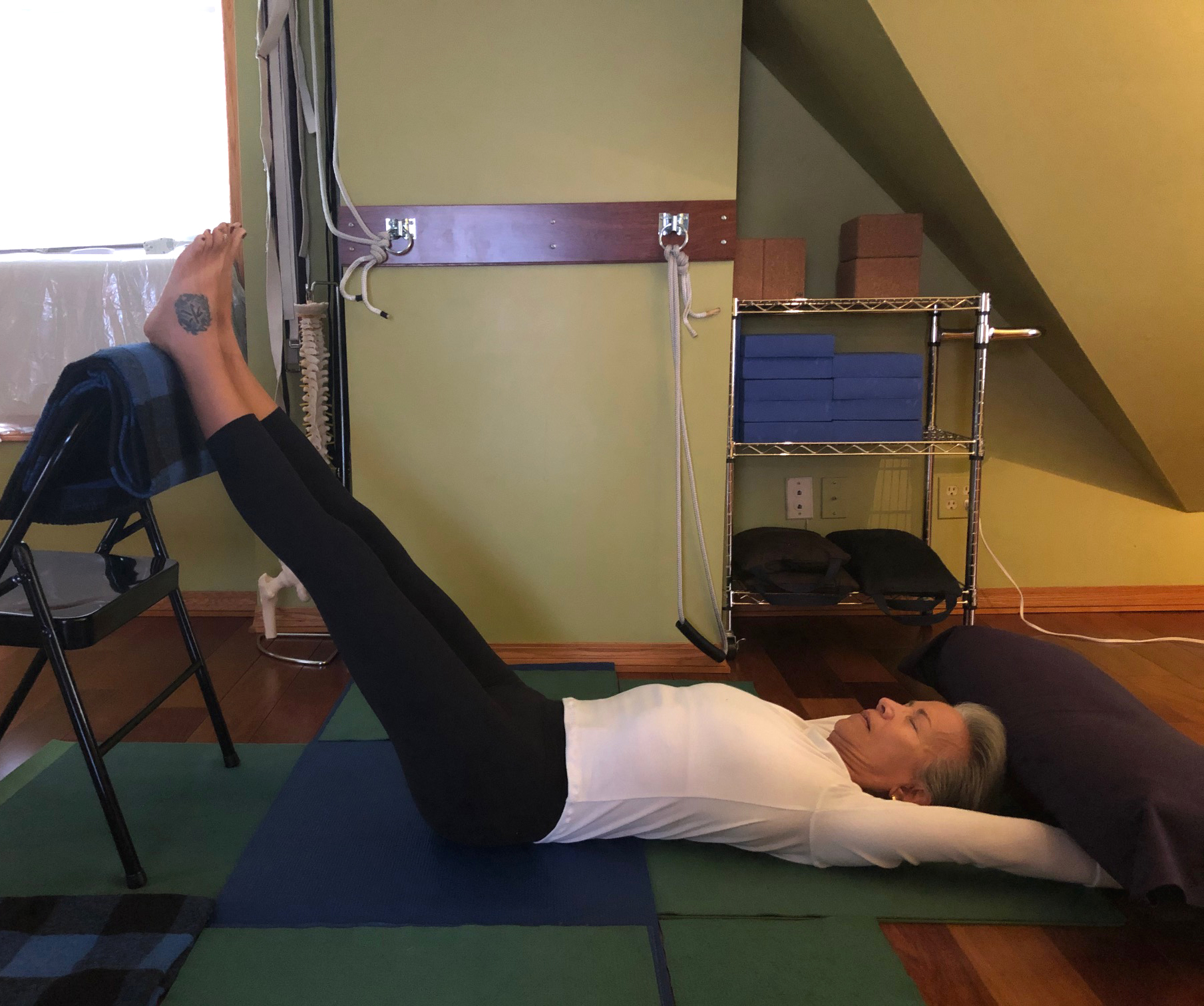
3) extend arms; bolster on wrists & hands
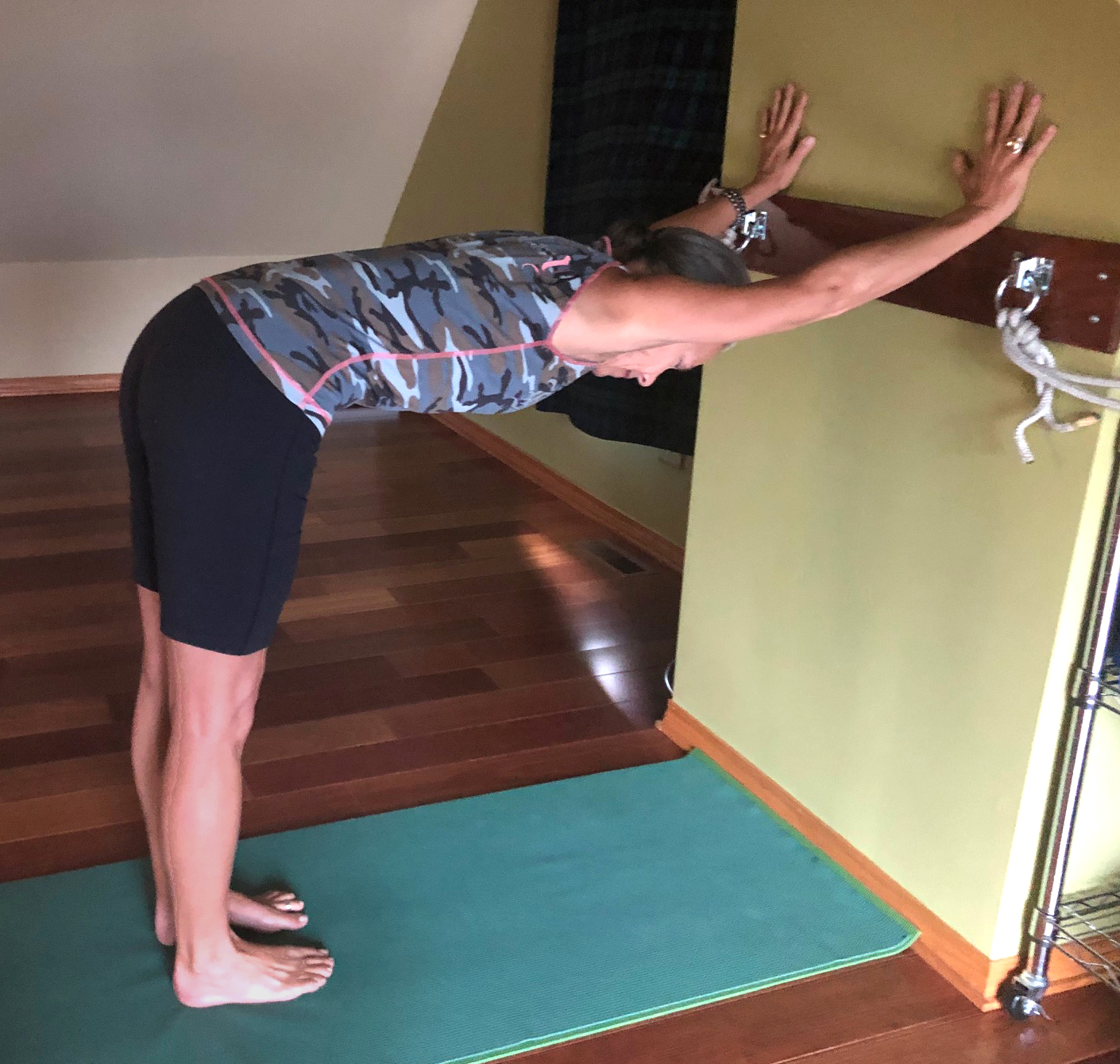
WALL STRETCH hands waist high 1 minute
to
VIRABHADRASANA I (Warrior I) 1 minute each side
– toes up wall
– straight arms into wall
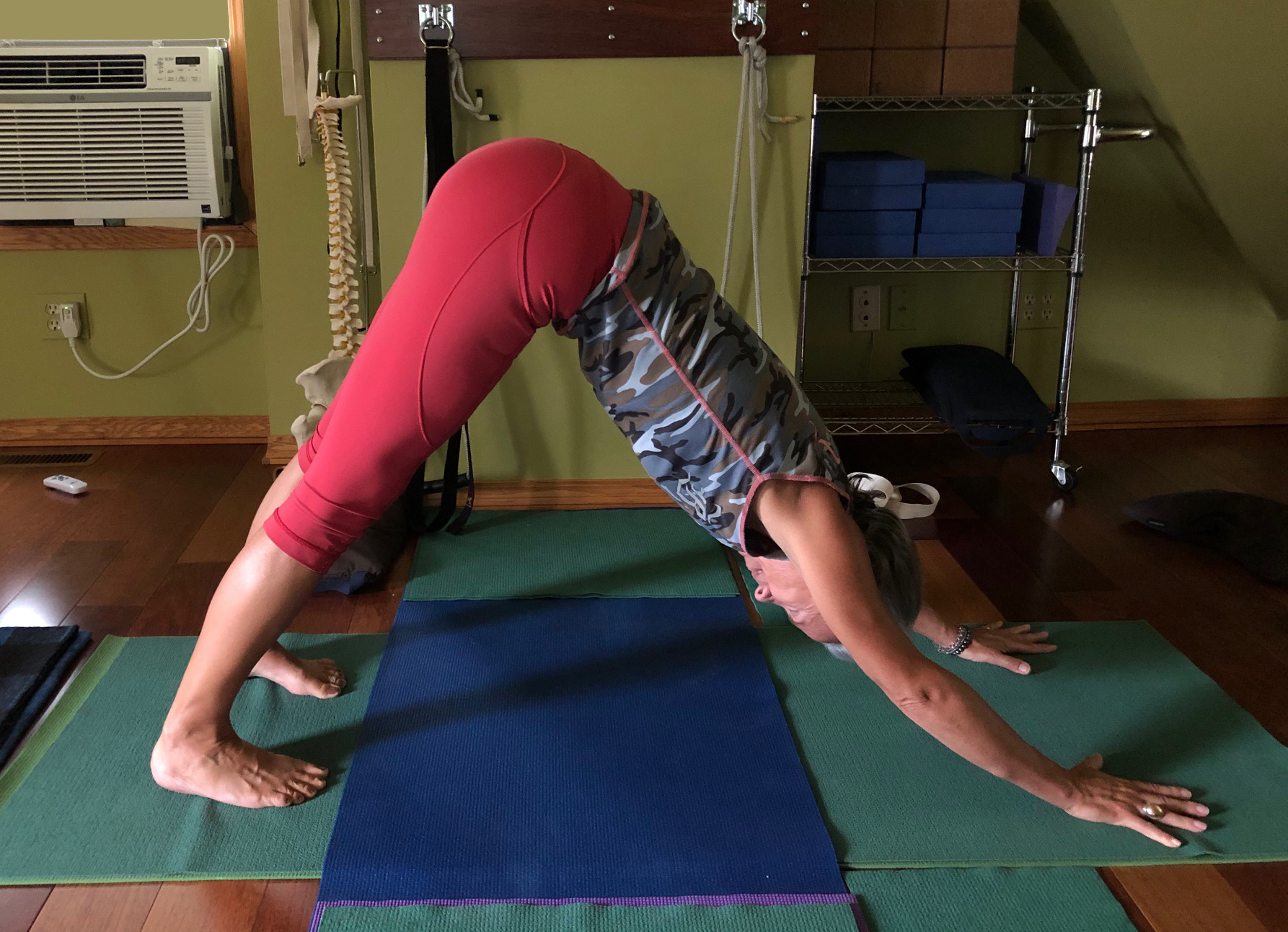
ADHO MUKHA SVANASANA (Downward Dog) 1 minute
SIRSASANA (Headstand) 1 minute
– Choose your Sattva variation

NIRALAMBA SARVANGASANA (Shoulderstand) 2 minutes
– Choose your Sattva variation

UPAVISTHA KONASANA (Wide-angle Seated Forward Bend) 2 minutes
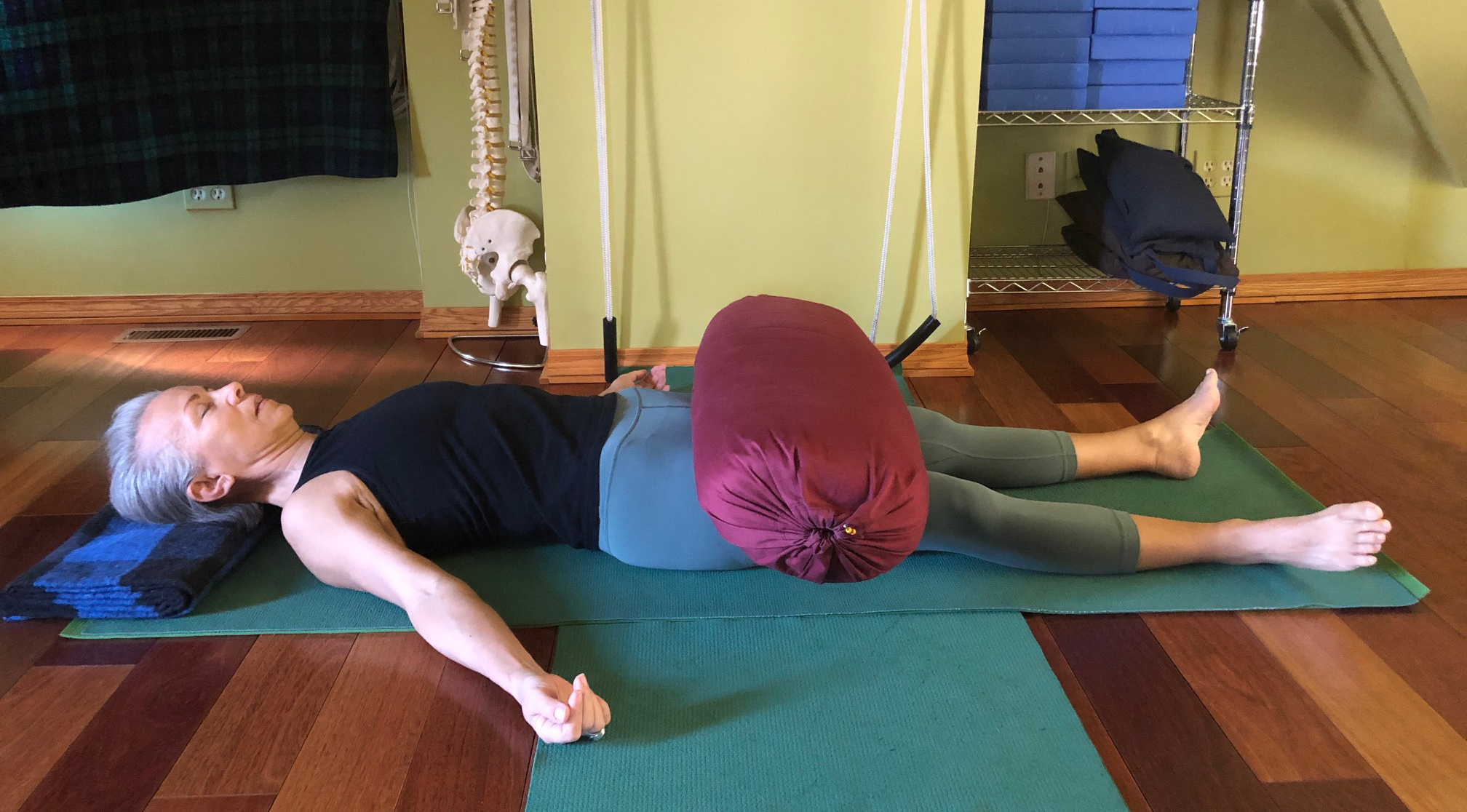
SAVASANA (Corpse): 5 m
– bolster across thighs
- Soften the inside lining of your mouth. Notice how the tongue drops away from the roof of your mouth. What other impacts/sensations do you notice? PAUSE 1 minute
- Soften and expand (make porous), the skin of the soles of your feet. Notice how the back of the hips relax and release? What other impacts/sensations do you notice? PAUSE 1 minute
- Soften and expand (make porous), the skin of the palms of your hands. Notice how the shoulder blades move into alignment in the back body. What other impacts/sensations do you notice? PAUSE 1 minute
May you refine who you are to align with what is in each present moment.



